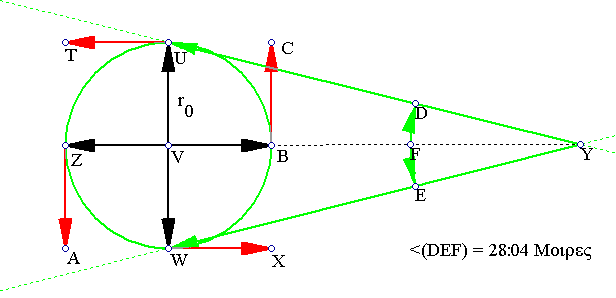
It is not accidental the setup on the article Using a Laser To Visualize Chaotic Turbulent Micro-Flow has been used in connection to time travel. The setup does indeed exhibit some interesting behavior which can be visualized easily. Consider the setup viewed side ways, as follows:

For a total spread angle DFE, the rotational movement of the laser beam gives rise to an angular frequency/velocity equal to ω=2*π/T. This in turn gives rise to a linear velocity v=ω*r, for the tip of the laser beam, which is realized at distance YV (as vectors UT, ZA, WX and BC).
Because v is a linear function of r, it follows that there is a r0 and thus a specific YV, at which the linear velocity will become equal to c=3*108m/s. This r0 will be of course a function of the period T, as well. Assuming a fairly small T, such as the speed 10,000rpm which is the speed of some of the fastest car engines, we get T=3/500.
Solving the equation c=v=ω*r for r, we get r0~286478.8m. Since r0/YV=tan(DFE/2), we get: YV=r0/tan(DFE/2), which for r0~286478.8m and DFE/2=π/9 gives: YV~787094.3m
What all this means: If we had set this thingy up, with a laser mirror angle equal to 2*θ=π/9 for example, then at the distance of YV~787 km, where the radius of the sweep circle will be approximately r0~286.5 km, we would get a 2D time-space singularity[1] (a circle). To create a 3D singularity[7], one needs to generalize the above in 3 dimensions, which can be done in at least two ways:
A mechanical time machine based on the above principle can be realized as a gyroscopic mechanism, with two rotating rings (green), anchored at AB and CD:
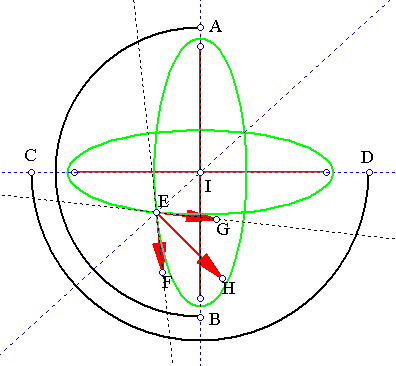
To create a singularity at E, the linear velocity there must be at least equal to c. Since the linear velocity EH is the sum of its components EG and EF, we must have: EG+EF=c. Because the two mechanical rings have (almost) the same diameter, we must have, r*sqrt(ω12+ω22)=c, from which we get the fundamental equation of the time machine with n=2 rings[3]:

For a speed of 10000rpm for both rings, we get r~202.5km.
An optical time machine based on the above principle can be realized again as a gyroscopic mechanism, but this time instead of mechanical rings we can rotate laser beams. How many laser beams? To find out, we remember that any point on the surface of a sphere can be described by its Euler Angles, (α,β,γ). Further, if a point A is rotated to position E by the Euler angles (α,β,γ), it can be shown that there exist angles (a,b,c) such that the following list of operations rotates point A again to E[4]:
Note that there are only two axes involved in the overall rotation when using angles (a,b,c). Therefore, we only need two rotating laser beams. Note also that this is equivalent to using one laser beam and two mirrors! A little judicious inspection shows that we can use the following mounting, as in the following figure[5]:
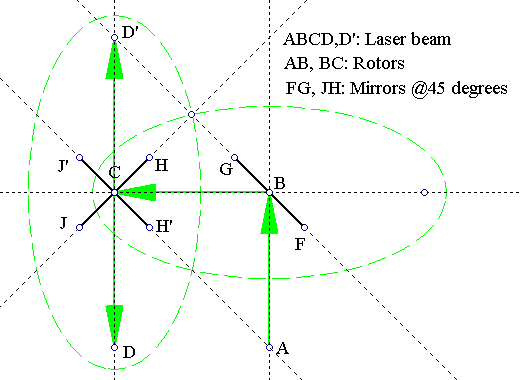
Choose the coordinate system to be that of Spherical coordinates. On the figure above then, denote as θ the angle of inclination and φ that of the azimuth. θ is realized as beam CD rotates around C and φ is realized as beam BC rotates around B (green ellipses).
For this setup then, if the rotation speeds of the two mirrors JH and GF have periods T1 and T2, then the equations for the two angles as functions of time t, are:
To create a 3D singularity then, the tip of the laser beam has to have a linear velocity v which satisfies the fundamental equation (above). And then, the phasor which describes the movement of the laser beam in 3-space as a function of time t, is given as:

When this laser setup rotates fast enough, we will get a 3D (spherical) singularity at critical radius r0. Plugging in some values, if the rotation speeds are 10000rpm, and 30000rpm, then T1=60/10000, and T2=60/30000, for which we get r0~90.6km.
The time for an observer inside the setup will be relativistically dilated and will be given as:
t'=t*γ=t/sqrt(1-(v/c)2)
where γ is now the Lorentz Factor. Note that v=r*sqrt(ω12+ω22), where r is the distance of the observer from B, hence the Lorentz factor becomes:
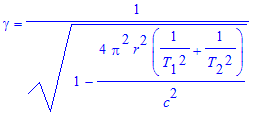
Follows a Maple graph of the relativistic time dilation for the above setup:
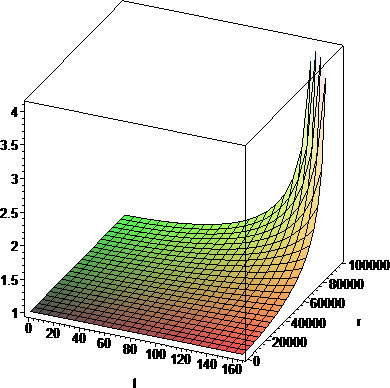
For example, at a distance of 90km, with rotation speeds of 10000rpm and 30000rpm, the Lorentz Factor will be γ~8.75. This means that for the observer inside the machine at this distance from the center, time passes at a rate 8.75 times faster than the time of an external observer. This means that the observer is moving into the future[6].